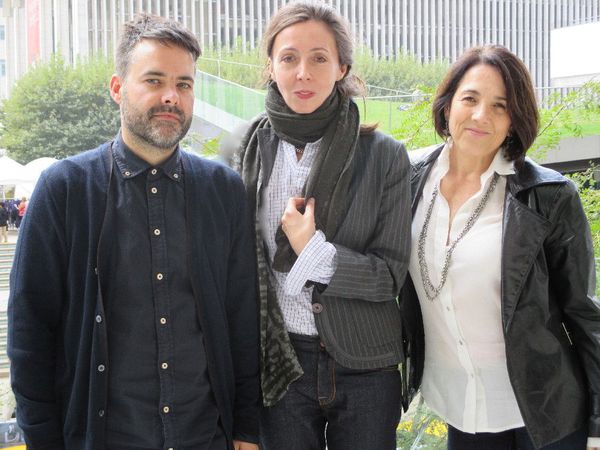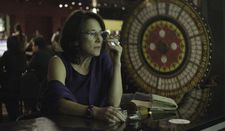 |
| Sebastián Lelio, Anne-Katrin Titze, Paulina García overlooking the plaza of Lincoln Center. Photo: Denise Sinelov |
During the New York Film Festival, I met up with Gloria star Paulina García and her director Sebastián Lelio to discuss costumes inspired by David Lynch's Wild At Heart, Chilean beatnik poetry, sphinx-y energy, and the rhythm of Gael García Bernal on the skateboard in Pablo Larrain's No synching up with a skeleton dance.
Paulina García plays Gloria with glorious abandon in Lelio's film about a woman who tries to find happiness. She is a divorcee, has grown children, goes to singles dances, works, does yoga, gets drunk, has an affair with Rodolfo (Sergio Hernández), the sheepish owner of an amusement park, and gets to tolerate a neighbor's visiting Sphynx cat, the naked center of the film, an omen of kindness to come.
Anne-Katrin Titze: Gloria wears many styles. Sequins and bright lipstick in one scene, yoga clothes in the next. She looks as though she hasn't made up her mind who she wants to be. Is she transforming?
Paulina García: Yes. I think she is in a gap, in a gap moment of her life. She is having a change and is not so conscious in the beginning. She is coming from the back line to the front line.
AKT: Is she using these clothes as a way of finding herself?
PG: I would say, finding again herself. More than defining. Finding something that is life again. That's it.
 |
| Director Sebastián Lelio on Gloria: "She is fighting her own revolution." |
Sebastián Lelio jumps in: Maybe we all use clothes like that. Since the film is in a way about nudity and skin, then of course clothes have a main role to play. For example for me the last jacket she wears, the shiny one. When the costume designer [Eduardo Castro] proposed it, I knew that was it, because it's like Sailor's jacket in Sailor Et Lula [David Lynch's Wild At Heart, 1990]. This represents my belief in individual freedom.
AKT: You are connecting the ending to David Lynch?
PG: I have to say, that I proposed that jacket. Because it's mine.
SL: It's yours?
PG: Yes. I have to say this because we had a big search trying to understand what she was going to use in the last scene. From the second week of shooting the costume designer was bringing me things and I thought, I don't know what I'm going to do with this scene. Finally, I decided to use my own dress and my own jacket. Both I had worn to accept a big prize in Chile.
AKT: In an earlier scene you are wearing a pumpkin colored net scarf that looks as if it had little crustaceans stuck in it. You wear it with bright shiny red lipstick while singing in the car, and there is an exuberance to the outfit. Gloria was going out fishing for fun?
PG: We were talking to the designer about this scarf. The clothes were a little bit too gray and too low for that scene.
AKT: Tell me about Gloria's relationship with the visiting cat.
SL: It's a Sphynx. That's the breed.
AKT: Does it function as a sphinx for Gloria? Is it a threshold guardian with a riddle?
SL: That's up to you! I guess it has a sphinx-y energy.
AKT: I love the background story with Noah and the cats coming out of a lion's nostrils.
SL: That's a mythical story. [Told by the character Victoria.] She is like a maid. She helps Gloria. You see her making the bed. They know each other.
PG: She is very comfortable with her. She has been working there [at her home] for years. That was the idea.
AKT: There is a lot of drinking going on in this film. With consequences.
PG: Sex, drugs, and rock n'roll.
SL: You know, we are Chileans.
AKT: Well?
 |
| Paulina García on Gloria: "I think she is in a gap." |
SL: No, I'm not even cynical. We drink. We drink when we eat. It's part of the cultural life. I mean, if you want to talk you have a bottle of wine.
AKT: In the film you show the effect of the drinking that others maybe don't. Gloria wakes up passed out at the beach one morning.
SL: Sometimes you drink too much and pay your price. I love this romantic ballad song that says 'I have paid a great price for living.' That's what she does. She is living. She's not in her house dreaming of a life, she's embracing life. What I'm trying to say, for me it has much more value and is much more respectable to have Gloria waking up at the seaside not knowing where she is and then rising again than a super-conservative lady who doesn't dare to put a foot in unknown territory.
AKT: Then you have the character of Rodolfo who is much more scared than Gloria. After his operation to lose weight he wears this bandage around his body, that, in a great scene, Gloria rips off him. Who is Rodolfo, though, we wonder?
SL: We like to think if the film was a [set of] tarot cards, then Rodolfo would be a figure who represents energies from the past and Gloria would be a more future oriented energetic figure.
PG: You can never avoid the context. You are always in a history. Even though your life is going on. Even when you are telling a little story you are always telling about your country. I like stories that are not trying to tell the whole history. We are not talking about dictatorship or educational protests in Chile, or our actual government. The film is not trying to tell that story. But anyway, the story cannot avoid it. The protest is going on around her.
AKT: I liked that Gloria is so unpredictable. She could go outside and join the protests at any moment.
SL: She is fighting her own revolution.
AKT: The dancing skeleton is a wonderful scene in the movie. The skeleton marionette of a street performer has black shoes and white gloves. I loved your reaction to it. What went on in your head while watching it dance?
PG: I don't remember exactly what I was thinking. When I watch it, I understand that life is unpredictable. And that he was making a film that is full of life, full of unpredictable moments.
SL: I was waiting to film that scene for ten years. I hadn't found a script to incorporate this. I saw this artist probably fifteen years ago in the streets of Santiago and just loved it. I was waiting for the moment to find a story in which it could match. The same as to find a script to work with Paulina.
AKT: The skeleton could have also fit into another recent film from Chile, No by Pablo Larraín, who is also the producer of Gloria. The rhythm and energy reminded me of Gael García Bernal on the skateboard.
SL: There is lightness. There is lightness against the weight and darkness of death. So in a way, Gael floating on the skateboard and this skeleton saying,' you know, we're going to die but let's dance', I think you could connect that.
AKT: The poem that culminates in the line 'If I were blood, I'd live in your heart' where does that come from?
SL: It comes from a great Chilean poet called Claudio Bertoni. He is in a way like a Chilean beatnik. A poet who has the talent to make poetry with nothing, with the simplest things. Take an apple and a bit of marmalade and a sock and mix them together and create something that hopefully is beautiful. For me it was an inspiration. He can see beauty there where no-one sees it.
AKT: The journey of the poem is interesting, the audience in the theater watching your film reacted with laughter and then seriousness and laughter again, asking what is this?
PG: The same mood of the movie. I think at the beginning you are laughing about her. She is having a mess with her life and she is funny. Then you start to feel a little compassion with her because she is lonely and she is not finding anyone to care. And lastly there is resilience and dancing.
AKT: Rodolfo is a kind of catalyst character for her transformation?
SL: He is lying. He is still attached. But I love him. I really like him because he is trying. In a way he is like Gloria but he doesn't have the tools.
 |
| Gloria and Rodolfo (Sergio Hernández) giving it a shot at Vertigo Park. |
AKT: He runs at the wrong moments.
SL: That's very Chilean. To avoid happiness and to escape.
PG: To get what you want, you have to make a decision. And that's what Gloria did. She decided to love this man. Anyway, he was the wrong man. She can realize what kind of man he is. She makes decisions and she pays a big price for it, to be alive.
AKT: My last question is about Vertigo Park, the amusement park Rodolfo owns. Any Hitchcock lessons there?
SL: I don't believe in closed scripts. For me scripts are maps. Like sensitive radars to life that include mysterious things that cannot be written. For me a script has to do more with the un-writeable than what you can write. We were searching for the location of this amusement park and we found this one called Vertigo.
Sebastián Lelio's radiant Gloria opens in the UK on November 1 and in the US on January 17 2014.





















